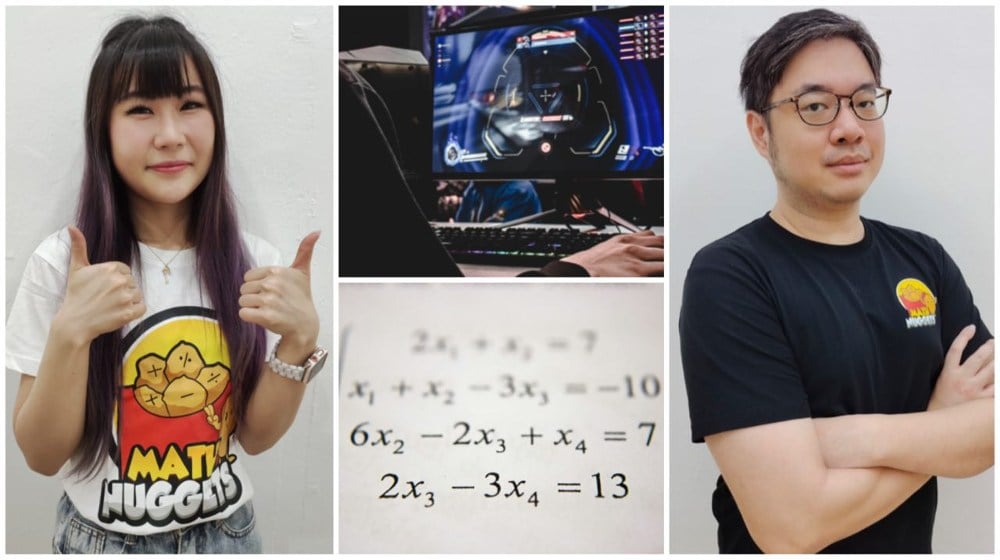Using Their Love Of Gaming To Put The Fun In Maths Fundamentals
For some of us, learning maths can be super difficult. Between all the equations and multi-step word problems, sometimes, not even tuition can save the day.
But what if maths could be as cool as playing your favourite video game? That's what Chelsea Chee and Jeremy Dong are bringing to Math Nuggets!
Chelsea started out crunching numbers as an ops and finance manager at RoboThink, where kids get to learn code and build robots. She didn't know a thing about coding at first, but dove in head first, learned the ropes, and ended up teaching there. She’s also an avid gamer of Counter-Strike 2, or Counter-Strike: Global Offensive (CS:GO), and incorporates the game theory into her lessons at Math Nuggets.
“Witnessing the growth and development of my students, experiencing the aha moments when they grasp a new concept, and contributing to their personal and academic success – all of this can be incredibly fulfilling,” says the 25-year-old.
Meanwhile, Jeremy, a former game designer, had always been teaching as a side hustle. He wanted to bring the core elements of video games into teaching in a different way. Despite struggling with maths in his youth, he now recognises how important the subject is in life, even it might seem unrelated at first.
“From watching students learn to approach mathematical problems from various angles, and being able to come to a solution on their own, to becoming more independent in their own learning, seeing students through their learning has become a very interesting and satisfying experience for me,” says the 34-year-old.
We caught up with Chelsea and Jeremy to find out more about their super cool way of teaching math – making the subject feel less like a chore, and more like a fun gaming adventure.
 IMAGE: MATH NUGGETS
IMAGE: MATH NUGGETS
We would have never paired CS:GO with learning maths! How are probability and statistics in this first-person shooter integrated into your lessons?
Chelsea: Economics in the game is important as players must manage in-game currency to purchase weapons and utilities to increase chances of winning. Teaching players about probability can help them understand the chances of winning a round, based on their economic decisions. They can calculate the probability of winning with certain weapons against different opponent set-ups and adjust their purchases accordingly. This relates to real-life examples when students are learning the topic of “money”.
Another mathematical element is strategy development, where probability plays a part. Players can use mathematical models to analyse opponents' behaviour, predict their actions, and devise counter strategies accordingly.
Understanding probability can help players anticipate enemy movements, exploit weaknesses, and gain a strategic advantage in-game. This correlates to students when attempting challenging math problems as well. It helps them to think out of the box, and strategise breaking down the questions into parts.
 IMAGE: MATH NUGGETS
IMAGE: MATH NUGGETS
You use “points systems and progression” in teaching maths. Tell us more.
Jeremy: One of the most basic definitions of a game is as follows: set a goal, and then set rules. I think that most students are motivated by a clear goal to work towards – of course, with some sort of reward to make the achievement extra sweet.
I gamify my learning experience by setting rules and conditions for certain activities for students, along with a reward/point system for them. Activities may be done solo or in a team, with various objectives such as deepening students’ understanding of the current math concept being taught or fostering teamwork and critical thinking.
Everyone likes different types of games. It’s the same with how students approach learning - no one is the same. I try to adapt my teaching style and presentation of content to every class dynamic by using the points system (feedback) in many areas, using progression and difficulty to slowly introduce them to more and more complex problems and concepts, and so on.
What's been the most memorable activity you've conducted, and what were the reactions from your students?
Chelsea: One memorable activity I conducted involved a simulation game called “Let’s go shopping!” It was when I transformed the classroom into different shop fronts. The students were handed a fixed amount of cash including dollar bills and coins to purchase what they wanted while they took turns to be cashiers.
It was interactive as I “brought” them to different shops such as McDonalds, Toys ’r’ Us and even Universal Studios. Their main goal was to use the least number of dollar bills and coins to pay for whatever they were getting. This was to [teach them how to] manage their income since they only had a fixed amount of money. The job of the cashier was to return the appropriate change to the “customers”. This fun activity helped them to learn about the concept of money and change. It is good to have a solid foundation of money and numbers, especially as it is something we use almost daily.
Jeremy: To teach the students the importance of time pressure and speed when doing math, I created a small competition where students had to compete to get as many questions about fractions correct in a short time frame. Points were awarded based on the number of answers correct. By incorporating game design elements, students were motivated to push themselves to perform in a challenging and competitive manner.
What are some of the success stories where your student's engagement and understanding of math noticeably improved thanks to you gamifying your lessons?
Chelsea: One of the games I’ve implemented in class is called Geometry Adventure. This involves incorporating gaming elements into a geometry lesson. Students had to explore different geometric shapes and properties to complete quests and unlock rewards.
By immersing students in a virtual world filled with interactive geometry challenges, they developed a deeper understanding of geometric concepts such as angles, shapes, and symmetry. Many students who initially struggled with geometry showed remarkable improvement in their comprehension and retention of geometric principles, as well as an increased interest in the subject.
Another game is called Math Olympics, where students compete in a series of math-related challenges. The games incorporated elements of competition, teamwork, and problem-solving, making learning math a fun and engaging experience for students. They not only improved their math, but also developed important 21st-century skills such as critical thinking, communication, and collaboration. This inspired many of them to continue exploring math-related activities outside of the classroom.
Jeremy: I like to explain to my students that math is like a game where you start off as a low-level player (low level of understanding) and by training (practice and hard work), you will be able to continue advancing and building on what you already have gained.
In secondary school Mathematics, students start off with basic algebraic manipulation, which will then lead to many advanced algebra topics as they progress from Sec 1 to Sec 4. By building a strong foundation in Sec 1 and 2, I have had students who realised that their hard work pays off when they reach the more advanced algebra topics in Sec 3, and realise that it is easy because of the amount of practice that they have put in in their earlier years. This reflects "practice makes progress" in games, where a player will have to put in hours of practice into a game to get better at it.
It’s a common misconception that gaming is distracting for kids. How do you address this with parents?
Chelsea: I emphasise the educational benefits of certain games. Some games I would encourage my students to play while answering math questions would be “Blooket”. I sometimes assign them homework from the game at home. I believe promoting moderation and balance is important as it is not feasible for a child to be doing work continuously in and after school – it isn’t exactly productive.
It is important to find alternative ways to help engage them in learning. Such educational game platforms will be a good way to encourage them, and get them eager to learn. Other than just playing educational games, students (like all humans) must be able to find an outlet to release their stress positively. Gaming is one [outlet] but encouraging parental involvement, and providing resources for responsible gaming is another. I usually ask my students if they play games, and what types of games they play.
Jeremy: I believe that most games can teach a certain skill to kids. For example, first-person shooters teach students about decision-making skills under pressure as well as reaction time.
Tabletop role-playing games promote creativity for players to create their own characters, create worlds and situations out of various keywords and visual stimuli, and craft unique situations for unexpected situations.
Resource management games teach the importance of balancing and keeping track of various resources that the player has, as well as improving planning skills and the ability to view situations from different angles.
Education games are excellent for the purposes of teaching, but there are many soft skills that can be picked up from various games as well. It is a two-way street: parents and children both need to recognise the various things that can be taught through different games.
What is the biggest challenge when it comes to teaching in today’s classroom?
Chelsea: Getting them to sit in class and do their work isn’t difficult, but getting them engaged, listening, and understanding concepts is challenging. If I were to use the same ways I used the previous week to implement concepts in the next lesson, I would be bored too!
It is important to stay up-to-date and understand what the kids are watching and playing out of class so that you can implement something similar as a game to capture their attention and interest.
Jeremy: I understand that kids learn in different ways and at their own pace. Therefore, I try to mix it up by letting them work alone sometimes, and team up with others at other times. This way, they can find what works for them, and feel more comfortable approaching various math problems.
We wish we had the chance to learn from you guys when we were younger! Are you planning to integrate more game elements into your curriculum?
Chelsea: One of the ideas I have would be to incorporate an annual “Math Nuggets Escape Room” where students of different levels can work together.
The idea is to transform the centre into an escape room where students who participate are split into two groups: one group would be the “prisoners” and the other would be the “releasers”. The main aim of the releasers would be to free the prisoners, and for the prisoners to escape. They would have to work closely together and solve math-related puzzles, riddles, and questions to unlock clues or hints given within the rooms to escape.
This is a game where lots of communication, strategising and critical thinking comes into place.
Jeremy: I plan to encourage open-ended exploration and experimentation in math, where there may be multiple valid approaches to solving a problem or interpreting a concept. This fosters a growth mindset and encourages students to think creatively and critically about mathematical ideas.
I would like to create situations in the classroom where interesting problems are presented, either through text or through a game format, where students can team up, and come up with various ideas/solutions to the situation. It can even be set as a tabletop role-playing game where their progress carries on over each week.
For the latest updates on Wonderwall.sg, be sure to follow us on TikTok, Telegram, Instagram, and Facebook . If you have a story idea for us, email us at [email protected].

/roundup_10_may_2024_rectangle.jpg?sfvrsn=23a152ba_1)








-by-volunteering-together/2ndas_family.jpg?sfvrsn=49ac4ef5_1)
